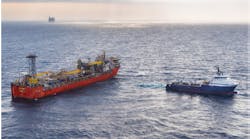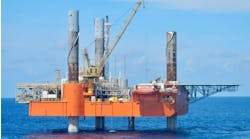Jeremy Beckman • London
Independents prosper in Norway licensing
Norway has issued 52 new production licenses under its Awards in Predefined Areas (APA 2007) licensing round in the North Sea, Norwegian Sea, and Barents Sea. All the awards are in areas already open to petroleum activity.
Operatorships were spread among 19 companies, all European apart from Nexen, with 18 others awarded shares in licenses. StatoilHydro led the way with nine new operatorships, including license 488 in the Barents Sea, close to the Snøhvit field. In the same region, it secured a 40% stake in license 492, in partnership with Eni.
Of the remaining Norwegian contingent, Revus Energy gained five operatorships, one close to its recent Ragnarrock discovery in the North Sea. NOIL Energy and Det Norske Oljeselskap, currently in the process of merging, picked up a cumulative seven operatorships, while another, Norway’s Noreco, won three, two of them in relatively remote parts of the North Sea.
Among the foreigners, Centrica Resources operates five of the new licenses and Lundin Oil four. Lundin is one of the more active new drillers on the Norwegian shelf, recently proving an extension of the Upper Jurassic Nemo oil field in the North Sea, discovered in 1992. German companies also prospered in the awards, with E.ON Ruhrgas gaining operatorships of four licenses, and Wintershall two, both in the Norwegian Sea off central Norway.
Elsewhere in Europe, Britain’s Department for Business, Enterprise, and Regulatory Reform (BERR) has offered a record 2,297 blocks or part-blocks under the UK’s 25th offshore oil and gas licensing round. These include 72 blocks classified as “fallow” that were relinquished in 2007 as a result of insufficient new activity.
Oil & Gas UK’s chief executive, Malcolm Webb, welcomed this ruling, pointing out that almost one-third of all UKCS exploration and appraisal drilling over the past year had been on acreage made available via the Fallow and Promote license initiatives.
In the Irish sector, seven companies – headed by ExxonMobil – have applied for interests in newly available exploration licenses in the deepwater Porcupine basin. And in the Dutch North Sea, Amsterdam-based Smart Energy Solutions is the new operator of block Q7, which contains a small gas discovery drilled by NAM in 1973.
Volve jackup in production mode
StatoilHydro has brought onstream its Volve field in the North Sea, 20 km (12.4 mi) west of Stavanger. Operations for the $308-million development were outsourced to Maersk, which began drilling the first of the eight wells from the field’s jackup platform, theMaersk Inspirer, last summer. This is the sole jackup employed for production on the Norwegian shelf at present, although another is on its way to Talisman’s Yme development, also in the North Sea.
The newly onstream Volve platform is the world’s largest jackup, according to operator Maersk.
Volve has estimated oil reserves of 8.6 MMbbl and 1.5 bcm of gas. Produced oil is exported through a 2.5 km (1.55 mi) 8 in. (20.3 cm) pipeline to the storage tankerNavion Saga, which is equipped with a submerged turret loading buoy. The gas heads through a 5.1 km (3.2 mi) pipeline to the Sleipner A platform for processing and onward export.
Oil production should build to a peak of 50,000 b/d by spring 2009, with an estimated field life of up to five years. StatoilHydro says it may add a further five wells. According to analyst ScanBoss, Volve is one of several Norwegian fields under review for CO2 injection, possibly from Sleipner, as a means of lifting recovery.
In the Norwegian Sea, the company has submitted a three-well development plan for the deep-lying high-pressure/high-temperature Morvin light oil/gas field, which has estimated recoverable reserves of 70 MMboe. Reservoir conditions (800 bar-plus [80 MPa], 150º C) are similar to those in the nearby Kristin, which StatoilHydro describes as the most demanding development on the shelf to date.
Morvin’s pressure will be controlled by equipment built into two subsea templates. The wellstream will be sent to the Aasgard B semisubmersible platform for processing through a 20 km (12.4 mi) pipeline incorporating direct electrical heating for flow assurance. Assuming project approval, installations could start this summer. If the partners opt for a fourth well, development costs could rise to NOK9.9 billion ($1.89 billion). First oil is scheduled for 2010.
StatoilHydro also is considering tying in its recent Gamma gas discovery to the Aasgard infrastructure. The well encountered rich gas in a mid-Jurassic Fangst group formation 8 km (4.97 mi) southeast of the Mikkel field.
Judy set for expansion
ConocoPhillips has discovered an extension of its 2006 Jasmine gas/condensate find in the UK central North Sea. The jackupEnsco 102 drilled the structure in block 30/6-7, northeast of the Jasmine well. Following a flow test program, the rig will drill two sidetracks to appraise and delineate the two discoveries.
The results will be factored into development studies, with Jasmine likely tied back to the Judy complex to the east, according to the operator. Partner BG has estimated Jasmine’s reserves at 100-275 MMboe, which if confirmed, might warrant a wellhead platform.
In the southern UK sector, Venture has successfully appraised the Ensign gas field in blocks 48/14a and 48/15a, via an extended reach horizontal well hydraulically fractured five times to improve productivity. This achieved stabilized test rates of over 40 MMcf/d, enough to justify development via an unmanned platform tied back to nearby infrastructure. Venture estimates proven and possible reserves at over 120 bcf.
West of Shetland, BP is considering a two-well subsea tieback to its Foinaven FPSO, following an oil discovery on the South-West Foinaven prospect. The well was drilled by the semisubPaul B Lloyd Junior 11 km (6.8 mi) southwest of the platform to a depth of 2,528 m (8,294 ft) below sea level.
Nini gains second platform
DONG is set to expand its Nini field development in the Danish North Sea. The Danish Energy Agency has approved the company’s DKK2.1 billion ($425 million) plan for the Nini East oil and gas accumulation, drilled and appraised last year by the jackupNoble George Sauvageau.
The scheme is based around a 10-slot unmanned platform, similar to the existing installation on Nini which entered service in 2003. The two will be connected with pipelines for multiphase flow, gas lift, and water injection, and the Nini platform also will be modified to accommodate the extra oil production.
DONG will implement a phased development, the first phase involving two horizontal producers and one water injector well. Later it may put in another horizontal well and/or water injector. All production will continue to be sent to the Siri platform for processing.




